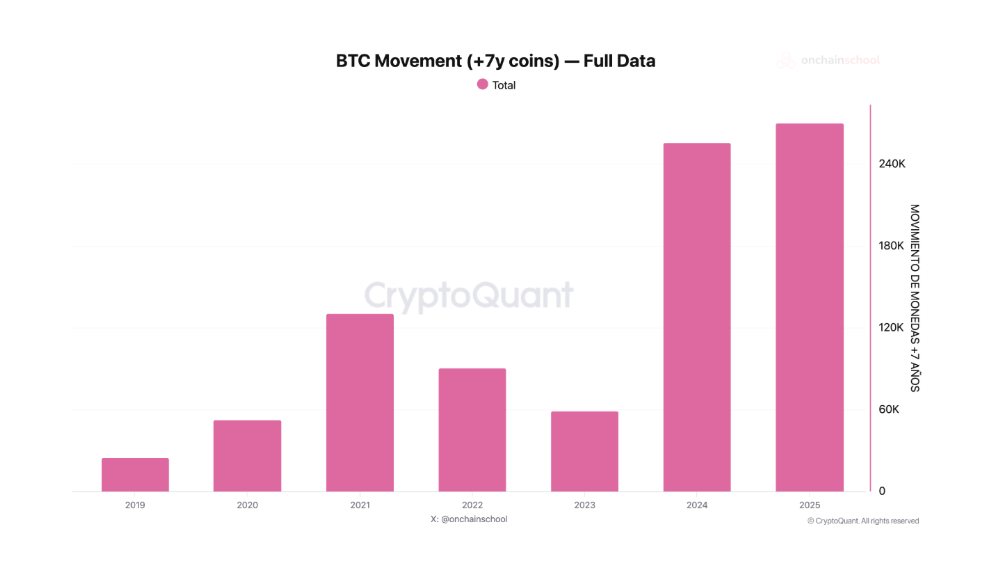In 2025, a record number of old Bitcoin whale wallets, particularly those dormant for over seven years, activated and transferred coins amid Bitcoin’s price surges. These movements included coins from as early as 2010 and 2013, often from original genesis whales, hack-related addresses, and former exchanges, signaling a shift in long-held holdings.
-
Record Whale Activity: Over 14-year-old wallets moved significant BTC volumes, including one transfer of 80,000 BTC.
-
Price Peaks Trigger Moves: Bitcoin’s rallies in 2025 prompted dormant whales to either secure assets or realize gains without full sales.
-
Market Absorption Strong: Despite sales, Bitcoin’s market cap absorbed the pressure, with over 50% of supply still in individual hands per on-chain data from analysts like CryptoQuant.
Discover how 2025’s BTC whale movements from ancient wallets impacted prices and strategies. Explore record transfers, market resilience, and key trends in Bitcoin holdings—stay informed on crypto shifts today.
What Are the Key Bitcoin Whale Movements in 2025?
Bitcoin whale movements in 2025 marked a historic surge in activity from long-dormant wallets, driven by sustained price appreciation. Wallets inactive for seven years or more transferred substantial holdings, including rare instances from 2013 and even 2010 eras, reflecting a reactivation of early Bitcoin accumulators. This trend highlighted evolving strategies among large holders, from direct sales to alternative value extraction methods like lending and corporate treasury integrations.
How Have Old Whale Wallets Contributed to These Movements?
Old whale wallets, often holding coins mined in Bitcoin’s nascent years, played a pivotal role in the 2025 landscape. On-chain data from blockchain analytics firms such as CryptoQuant revealed that transfers originated primarily from original genesis (OG) whales, including addresses linked to past hacks and defunct exchanges. One standout event involved an unidentified whale transferring 80,000 BTC after 14 years of dormancy, underscoring the potential scale of these activations.
Further illustrating this, a wallet from the Satoshi mining era, which once controlled up to 8,000 BTC, recently offloaded 150 BTC to exchanges, reducing its balance to approximately 3,850 coins. These movements were not isolated; a series of price peaks throughout the year incentivized action, as holders capitalized on valuations far exceeding acquisition costs. Experts note that while some transfers went directly to exchanges for liquidation, others explored non-selling options, such as staking or lending protocols, to generate yield without parting with principal assets.
The robustness of Bitcoin’s ecosystem in 2025 facilitated these shifts. Institutional adoption and the rise of perpetual decentralized exchange (DEX) trading provided whales with sophisticated tools to hedge or speculate. For instance, some OG whales relocated ancient coins to DEX platforms for derivative positions rather than spot sales, minimizing immediate market disruption. This adaptability helped maintain price stability, even as large volumes circulated.
 The price peaks of BTC incited more old whales to move their coins, either for security or to realize profits. | Source: CryptoQuant.
The price peaks of BTC incited more old whales to move their coins, either for security or to realize profits. | Source: CryptoQuant.BTC Absorbed Most of the Whale Selling
Despite the influx of whale selling in 2025, Bitcoin’s market demonstrated remarkable resilience. The total supply, bolstered by a growing institutional base, absorbed these outflows without catastrophic dips. Short-term pressures from large spot sales occasionally nudged prices downward, particularly when combined with short positions in derivatives, as some whales aimed to amplify gains through leveraged strategies.
Blockchain researchers from firms like Glassnode have observed that the market’s depth increased this year, with ETF inflows and corporate treasuries acting as buffers. One notable pattern was the use of perp DEX trading, which surged in popularity among whales. This allowed holders of vintage BTC to engage in futures markets, providing liquidity and exposure without fully liquidating spot holdings. As a result, the overall impact on Bitcoin’s spot price remained contained, with volatility metrics showing moderation compared to previous cycles.
Over 50% of BTC Is Still Held by Individuals
Amid these whale activities, the distribution of Bitcoin holdings remained heavily skewed toward private individuals. Analytics from on-chain tracking platforms indicate that approximately 53.48% of the circulating supply resides in personal wallets, with around 170,000 such addresses identified and monitored. This figure encompasses a broad spectrum, from micro-holders to ultra-wealthy whales, highlighting Bitcoin’s decentralized ethos even as institutions gain ground.
Smaller participants showed vigorous engagement in 2025. Over 2.41 million new “shrimp” wallets—those holding less than 1 BTC—emerged, signaling grassroots accumulation. Similarly, the “shark” category (10 to 100 BTC) expanded with 3,461 new wallets, while mid-tier whales (100 to 1,000 BTC) continued steady growth. On the larger end, 14 wallets exceeding 10,000 BTC underwent splits or transfers, and 20 in the 1,000 to 10,000 BTC range activated, demonstrating that even fewer large players can influence dynamics.
Corporate treasuries accumulated nearly 1 million BTC this year, yet their holdings exert minimal direct pressure due to long-term holding strategies. In contrast, active trading from newer whales—often more agile—can sway sentiment with relatively modest transfers. This interplay underscores Bitcoin’s market maturity, where individual holders maintain majority control despite whale movements.
Broader trends reveal a maturing ecosystem. On-chain investigators have meticulously tagged treasuries, miner reserves, exchange reserves, and custodial/ETF wallets, providing transparency into flows. Expert commentary from figures like those at Chainalysis emphasizes that while whale activations grab headlines, the influx of retail and institutional participants dilutes their singular impact, fostering a more balanced price discovery process.
Frequently Asked Questions
What Triggered the Record Bitcoin Whale Movements in 2025?
Bitcoin’s successive price peaks in 2025, reaching new all-time highs, prompted dormant whales to move coins after years of inactivity. Wallets over seven years old, including some from 2010, transferred holdings to secure assets or access liquidity, with data from CryptoQuant showing this as the highest annual activity on record for such ancient addresses.
Are Old Whale Wallets Still Influencing Bitcoin Prices Today?
Yes, movements from old whale wallets continue to play a role in Bitcoin’s price dynamics, though the market’s increased liquidity tempers their effects. In 2025, sales were absorbed effectively, and strategies like lending allowed whales to extract value without flooding exchanges, helping stabilize prices even during high-activity periods.
Key Takeaways
- Historic Reactivation: 2025 saw unprecedented moves from wallets dormant since Bitcoin’s early days, including a 80,000 BTC transfer after 14 years.
- Market Resilience: Bitcoin absorbed whale selling pressures, supported by institutional inflows and derivative tools like perp DEX trading.
- Individual Dominance: Over 53% of BTC remains in private hands, with new small-holder wallets surging, indicating broad-based adoption.
Conclusion
The Bitcoin whale movements in 2025 from old wallets represent a fascinating chapter in the asset’s evolution, blending legacy holdings with modern financial strategies. As over 50% of supply stays with individuals and markets prove adept at handling flows, these events reinforce Bitcoin’s enduring appeal. Looking ahead, monitoring on-chain activity will be crucial for investors navigating potential volatility—consider diversifying your portfolio to capitalize on these trends.






